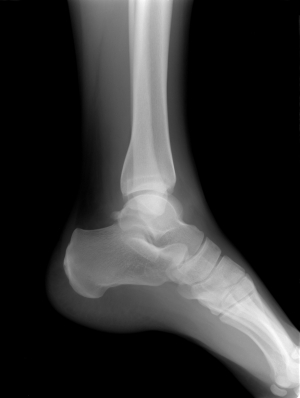Stress Fracture or Shin Splints?
Consult a Doctor to be Sure, but Here are Two Clues


Shin splints are to runners what kryptonite is to Superman. We shy away from them since this injury will force lower mileage for us for weeks.
This can be a real source of depression for someone following a focused training program for an anticipated target race. Tapering is for the end of your training schedule, not before.
The Symptoms of Shin Splints
What are the symptoms? Almost always you’ll feel a nagging pain alongside your tibia, in the connective tissues that fasten your muscles to your bone.
Specifically, the pain presents itself when you flex your foot, as in normal walking. You will feel it along the front of your leg between your ankle and knee.
You Might Have a Stress Fracture
But what if your self-diagnosis is wrong and it’s not shin splints, but in fact a stress fracture? This condition is in reality a partial crack in your shin bone, what your sawbones would call your tibia.
The issue with identifying this particular injury correctly is that the general area is the same and the nature of the pain may be virtually identical.
How can you distinguish between the two injuries? Although a doctor is the only person that can diagnose it positively, there are a couple of clues. A stress fracture will be very localized, right where the crack lies has developed. Conversely, since shin splints are a condition associated the connective tissue, the pain usually extends a longer distance, but not always.
Consider These Diagnostic Clues
To ID the situation yourself, lightly feel along your shin. How localized is your pain? The answer might offer one clue. Another clue that with shin splints, the pain you experience may vary throughout the day. This is also common with plantar fasciitis because connective tissue tends to loosen up with movement during the day.
Since it contracts and goes into repair mode as you sleep, shin splints will offer more intense pain early in the morning. It will slowly lessen as the tissues relax and lengthen with activity.
Conversely, bone does not contract when you’re resting, so it will less painful early in the morning and progressively become more painful during the day as the pressure increases.
Common Shin Splint Treatment
The advice from the Mayo Clinic is fairly standard:
- Rest. This makes sense; avoid putting weight on it as much as possible. Yes, of course you want to stay on target with your running but spend some time in the pool instead.
- Use Ice Packs. Apply ice several times a day. I don’t use actual ice myself—I use a bag of frozen peas. I apply the frozen bag and when it has thawed, back in the freezer it goes. Don’t eat the peas.
- Elevation. Prop that leg up higher than your heart. At your desk you might have to use a stack of books on your desktop; in bed, a couple of pillows will do.
- Use an Over-the-Counter Pain Reliever. Try ibuprofen (Advil, Motrin, etc.), naproxen sodium (Aleve or your grocery store brand) or acetaminophen (Tylenol, etc.).
Common Shin Stress Fracture Treatment
Since this condition is more severe, it follows that the treatment is as well. All the above treatments apply, but your doctor might want to go further.
He or she might prescribe a walking boot or brace or crutches. In more severe cases, he might recommend immobilizing the bone with a splint or cast. In the most severe situations, surgery might be an option, although it is rare.
The bottom line? Consult your doctor. And quick, before the government health care rationing starts. If you have experiences or tips for our readers, please share them below.
Recommended Related Articles
- Curing Plantar Fasciitis
- Specific Stretches Relief for Runner’s Knee
- The True Cost of Obamacare
- Cross Training for Runners
Website © 2010 KSmith Media, LLC; all rights reserved. Webmaster’s Google profile












